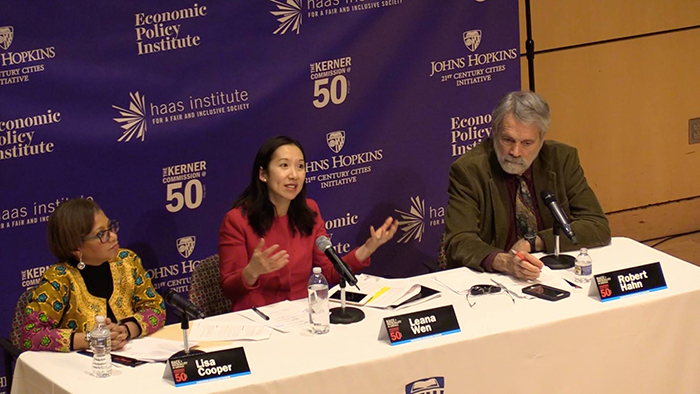
May 17, 2018
By Mac McComas, Program Coordinator, 21CC
On the 50th anniversary of the February 29, 1968 release of the Kerner Report, the Johns Hopkins 21st Century Cities Initiative teamed up with the Haas Institute for a Fair and Inclusive Society at University of California, Berkeley to explore the legacies of the Kerner Commission and discuss what a Kerner Report would look like in contemporary America. The bicoastal conference, simulcast for live audiences in Baltimore and Berkeley, brought together researchers, advocates, policymakers, and practitioners to discuss issues of race and inequality in housing, education, health, and criminal justice, and to explore forward-thinking policy solutions.
History of the Kerner Commission
After a summer of social unrest in cities across America, President Lyndon B. Johnson formed the Kerner Commission in July 1967 to uncover the causes of the recent urban riots and recommend solutions. Fred Harris, the former U.S. Senator from Oklahoma and the only living member of the Kerner Commission, was in Baltimore at the Reginald F. Lewis Museum to discuss the history, origins, and legacy of the Commission. According to Senator Harris, President Johnson gave the 11 commission members the following marching orders at a White House meeting: “Let your search be free, find the truth and express it in your report.” As Harris noted at the conference in Baltimore, “That is exactly what the Commission famously did, which not only shocked the conscience of the nation, but greatly upset President Johnson,” who viewed the critical report, in part, as an indictment of his Great Society programs that were aimed at eliminating poverty and racial injustice.
The Commission held 20 days of hearings, with 130 witnesses, ranging from Dr. Martin Luther King, Jr. to J. Edgar Hoover. In addition, the Commission conducted site visits in 23 cities to some of the communities most affected by the 1967 rioting. Senator Harris, along with Mayor John Lindsay, went to Cincinnati and heard frequent calls for jobs. But it was a visit to a black barbershop in Milwaukee that was most informative for the team, where they came to realize the extent of racial segregation and inequality in northern cities. These site visits greatly informed the findings of the Kerner Report.
Watch Senator Harris recount the full story below. Watch the full panel, History, Origins, and Legacy of the Kerner Commission here.
“Great and sustained national efforts were required, not only to combat racism, but also to greatly expand social programs,” the commissioners stated in the Kerner Report. These efforts did meet with initial success. Senator Harris highlighted that there was some progress in reversing the ills outlined in the report in the immediate decade following its release, however, “regression has been the trend since the mid-1970s.” as detailed in recently published findings by the Economic Policy Institute.
Health and Race
One was are where that regression is evident is in racial disparities in health. Lisa Cooper, Bloomberg Distinguished Professor at Johns Hopkins University School of Medicine and Bloomberg School of Public Health, began the Health and Race conversation by highlighting that health, unlike all the major issue areas covered in the Kerner Report, including education, jobs, and policing, did not have its own section. While the topic is unique in that way, the authors did include health in the report, calling out racial disparities in infant mortality, life expectancy, access to care, and the role of neighborhoods in determining health outcomes.
As Robert Hahn, epidemiologist at the Centers for Disease Control and Prevention (CDC), noted, “health is the canary in the coal mines of society,” and the persistent racial disparities across a multitude of health indicators will not disappear until similar disparities in housing, education, and employment are addressed. Hahn concluded that despite an increase in the recognition of the importance of public health since the release of the Kerner Report, we still have a long way to go in addressing the social determinants of health.
Baltimore City Health Commissioner Leana Wen highlighted the persistence of many of these racial inequalities across health indicators, including a 20-year difference in life expectancy between lower-income predominantly black neighborhoods and upper-income predominantly white neighborhoods. Even so, she noted there are present-day success stories in the field of public health that need to be told. B’more for Healthy Babies, for example, has achieved a 40 percent reduction in infant mortality in seven years and a 50 percent reduction in infant mortality racial disparity. The Vision for Baltimore program provides eyeglasses to the over 10,000 Baltimore City children in K-8 schools that need them, regardless of ability to pay. These types of interventions in public health, Commissioner Wen pointed out, make a big difference in other aspects of life and demonstrate to the public how important it is to address these inequities.
Watch Baltimore City Health Commissioner Leana Wen discuss successes the city has had in addressing public health disparities. Watch the full panel on Health and Race here.
Read more about some of the policy remedies proposed at the Kerner Conference here. Watch videos from the full conference here, view photos from the conference here, see media coverage of the conference here, and access conference materials and presentation slides here.

